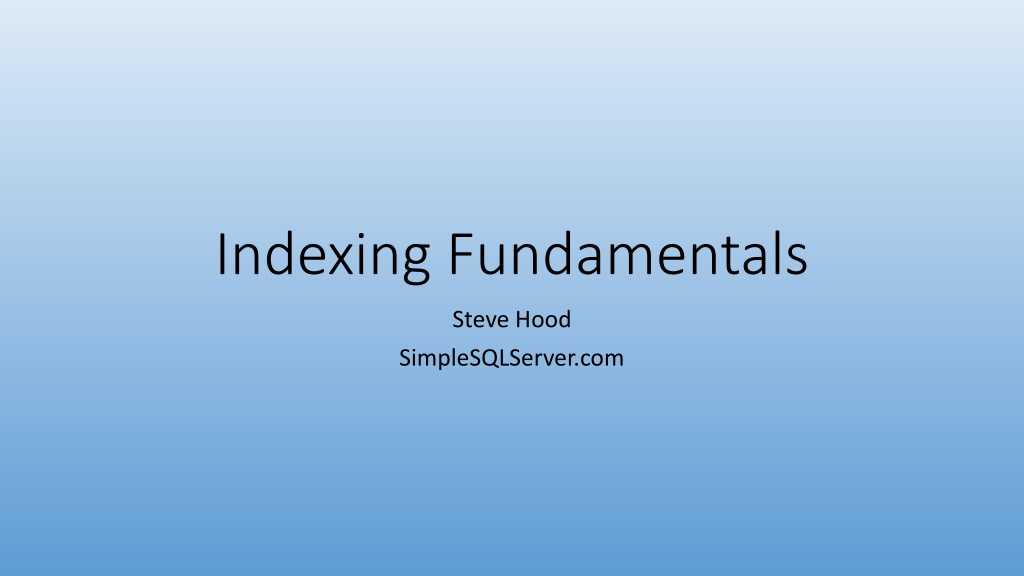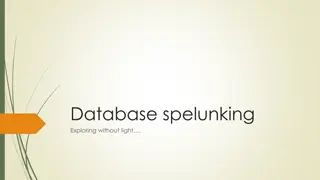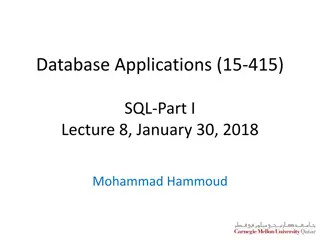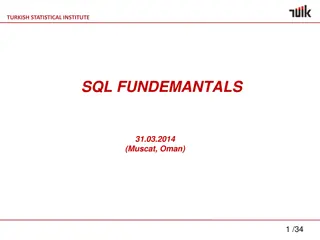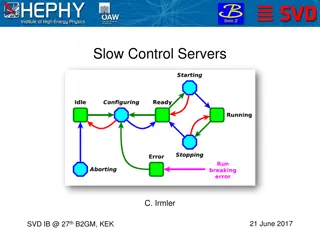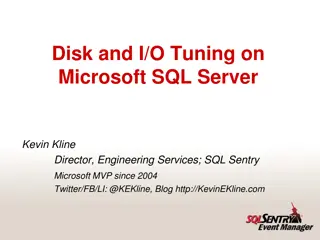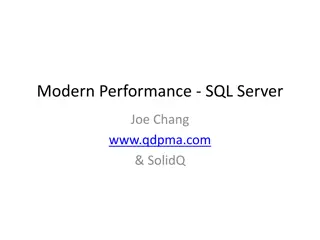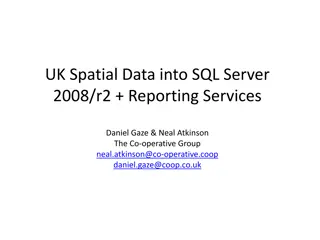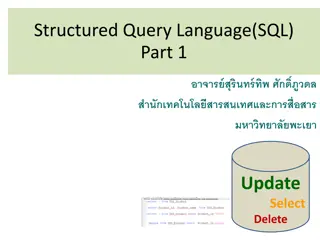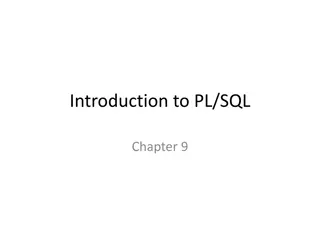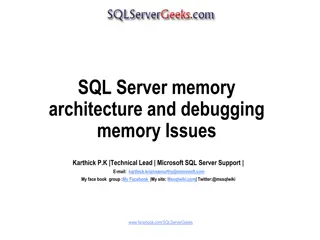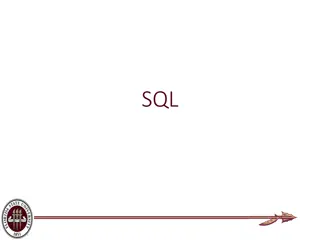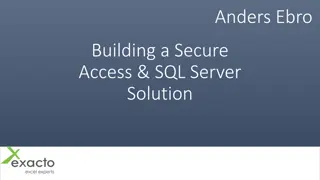Understanding Indexing Fundamentals in Simple SQL Server
Explore the basics of indexing in SQL Server with a focus on clustered and nonclustered index types, their uses, costs, & optimization. Learn the importance of SARGable queries, execution plans, and how indexes impact database performance.
Download Presentation

Please find below an Image/Link to download the presentation.
The content on the website is provided AS IS for your information and personal use only. It may not be sold, licensed, or shared on other websites without obtaining consent from the author. Download presentation by click this link. If you encounter any issues during the download, it is possible that the publisher has removed the file from their server.
E N D
Presentation Transcript
Indexing Fundamentals Steve Hood SimpleSQLServer.com
The Rules Interrupt me Learn it as though you ll teach it Don t leave without understanding
Outline Index Types, focusing on clustered and nonclustered How indexes are used and abused The costs of clustered and nonclustered indexes Cleaning up unwanted indexes Links
Index Types Heap (Not really an index) Clustered Nonclustered XML Spatial Full-Text Columnstore Hash
Clustered Index Telephone book Multiple keys Last Name First Name Middle Initial Address Phone Number
Heap Reference book without a table of contents. Has a page number It just happens to be in that order Rare to have a legitimate use Very small tables, although it doesn t enforce uniqueness Very large tables always referenced through other indexes Significantly faster on inserts? This is a common myth
Nonclustered Index Index at the back of a book Example of a single key with either RID or Clustered Index Key
SARGable SARGable = Search Argument capable Bad: LastName LIKE '%Hoo%' Good: LastName LIKE 'Hoo%' Bad: Year(DateAdded) = @Year Good: DateAdded >= Cast(Cast(@Year as VarChar(4)) + '-1-1' as DateTime) AND DateAdded < Cast(Cast(@Year + 1 as VarChar(4)) + '-1-1' as DateTime) Bad: DateDiff(DAY, DateAdded, GetDate()) < 7 Good: DateAdded > DateAdd(DAY, -7, GetDate())
Execution Plans Do NOT look at the whole plan SET STATISTICS TIME ON SET STATISTICS IO ON Indexes and Heaps are referenced in just three ways Scan Seek Lookup
Scan Read every row in an index or heap Not always a bad thing Using most or all records Not always a good thing Non-SARGable arguments used Lack of a Seek Predicate in an Execution Plan Denny Cherry: Seeks Aren t Always Better Than Scans Rob Farley: Scans Are Better Than Seeks
Seek Find rows in an index knowing at least part of the first key field Heaps don t have key fields, so you can t seek. Typically more efficient Executing 1000 seeks can cost more than 1 scan (see links on last slide) Does not mean it filtered it down much Does not mean it didn t scan through the rest of the records If there is a Predicate, there is at least one piece not handled by the key field(s)
Lookup A nonclustered index was used, but didn t have all the columns RID Lookup on Heaps Key Lookup on Clustered Indexes Can be justified Less used query Large columns (especially XML, VarChar(Max), etc) Large number of columns
Covering Index A single index that has every column requested by the statement A clustered index includes every column Always a covering index A nonclustered index can be by adding included columns Updates are more likely to need to update this index Index is larger Disk Backups Memory
Scan Demo -- All demos are done on base install of AdventureWorks2008 --Also, all work on all supported versions of SQL Server SET STATISTICS IO ON SET STATISTICS TIME ON --SARGable Scan and Seek SELECT LastName, FirstName FROM Person.Person WHERE LastName LIKE '%simps%' SELECT LastName, FirstName FROM Person.Person WHERE LastName LIKE 'simps%'
Seek Demo SET STATISTICS IO ON SET STATISTICS TIME ON --Seek examples --Didn't filter it down much SELECT LastName, FirstName FROM Person.Person WHERE LastName LIKE '[a-m]%' --Scanned through the rest of the records SELECT LastName, FirstName FROM Person.Person WHERE LastName LIKE '[a-m]%' AND FirstName = 'Steve'
Lookup Demo SET STATISTICS IO ON SET STATISTICS TIME ON --Lookup Examples IF EXISTS (SELECT * FROM sys.indexes WHERE object_id = OBJECT_ID(N'[Person].[Person]') AND name = N'IX_Person_LastName_FirstName_MiddleName_INCL') DROP INDEX [IX_Person_LastName_FirstName_MiddleName_INCL] ON [Person].[Person] GO --Able to do the same seek, but had to do a Lookup to get the EmailPromotion SELECT LastName, FirstName, EmailPromotion FROM Person.Person WHERE LastName LIKE '[a-m]%' AND FirstName = 'Steve'
Covering Index Demo --Covering Index Example CREATE INDEX IX_Person_LastName_FirstName_MiddleName_INCL ON Person.Person ( LastName , FirstName , MiddleName ) INCLUDE ( EmailPromotion ) --Same select statement we used last time SELECT LastName, FirstName, EmailPromotion FROM Person.Person WHERE LastNameLIKE '[a-m]%' AND FirstName = 'Steve'
Filtered Index Add a WHERE clause to an index declaration Must match the WHERE clause in a query Index on Orders WHERE status is open Will probably be less than 1% of the results Index on Items WHERE QtyInStock > 0 Filtering by a common value that greatly reduces the number of rows Must be filtered by static values Can t do WHERE DateAdded > DateAdd(DAY, -7, GetDate())
Indexed Views Require certain settings to be enabled by all connections editing data Changes to all tables involved can update the view Gets to be expensive Requires SCHEMABINDING on the view They have their place Few updates compared to reads Or updates done in a specific window where you can drop the index and recreate it later Joining the tables takes a lot of resources Can be used for aggregations Kendra Little wrote What You Can and Can t Do With Indexed Views
Index Costs Clustered insignificant differences to heap Nonclustered Data Modification Overhead Disk Space Backups Time and Size Memory
Memory Costs SQL Server reads and writes data in memory Writes ensure the page is in memory then updates it there Reads ensure the page is in memory then uses it from there SQL keeps data in memory as long as possible Page Life Expectancy shows how long it s expected to hang around This reduces load on disk Less trips to disk mean better performance, even flash disks are slower What is competing for your memory? Cleaning Up the Buffer Pool to Increase PLE
Index Cleanup Unused Indexes Sys.dm_db_index_usage_stats Make sure you trend over time Quarterly or annual reports DMV is reset on restart and can be reset on index maintenance Indexes Unused and Duplicates
Index Cleanup Duplicate Indexes Same first one or two key fields are typically considered duplicate More costly than unused indexes Can typically be combined More efficient even if new index is larger than any prior index Indexes Unused and Duplicates
Data Compression At a Glance Enterprise-Only feature Row and Page Compression Page is Row Compression + more B+Tree has Row Compression Uses more CPU because it uncompresses as it s being used Uses less memory because it s compressed in memory, too Uses less CPU and Disk IO for physical reads Less to read from disk Less data in memory, less memory pressure, lower data turnover Different data compresses at different rates (sp_estimate_data_compression_savings)
Posts I wrote for more info Fixing Page Life Expectancy (PLE) Cleaning Up the Buffer Pool to Increase PLE Indexing Fundamentals Optional Parameters Causing Index Scans Indexes Unused and Duplicates
